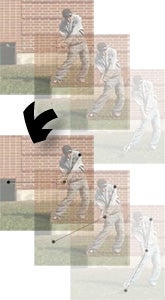Design team members: Ian Clarkson, Jason Jo, Simon Jones
Supervisor: Prof. John McPhee, P.Eng.
Background
Enjoy golf? Yes? Then you're one of over 60 million others worldwide!
Think your swing could use a little work? Yes? Then you're one of over 60 million others worldwide
The multi-billion dollar golf industry exists because every golfer has aspects of his or her swing that could use some improvement. Unfortunately, the most effective way of improving your swing is to take lessons from a professional -- something many people have neither the time nor resources for. So wouldn't it be great if you could examine all of the key aspects of your swing that a professional would, but at far less cost and at your own leisure? Enter the video-based golf swing analyzer...

The current array of swing analyzers are either mat- or video-based. A mat-based device operates by simply examining the swing at the point of contact with a ball. They may be used to predict the path of a golf ball after hitting it, but do not provide any information regarding swing mechanics prior to contact with the ball.
A video-based analyzer addresses this shortcoming by examining the entire swing, from backswing to follow-through. However, all current video-based analysis require that users manually identify the location of relevant points in the video: the club head, the shoulders, and so on. This process is both tedious and prone to error. Our project tries to automate this identification process, allowing users to spend more time improving their swings and less time sitting in front of the computer.
Project description
Our group is aiming to create a system capable of determining the characteristics of a golf swing based on images captured from a consumer-grade video camera. We want to provide a helpful swing analysis to a golf enthusiast who has a basic understanding of swing mechanics. The system will first analyze a video sequence, and subsequently generate a list of various metrics based on timing (backswing time, downswing time, follow-through time), speed (clubhead speed), and position (elbow angles, club angles). These metrics will provide users with valuable information as to how effectively they are swinging the club. They may also be compared to "ideal" values, identifying potential areas for improvement.
Design methodology
To ensure that we had at least a partially functioning system by the end of the course, we decided that an incremental design process would be ideal. To begin with, we didn't attempt to automate the entire capture and analysis process, but instead designed analysis algorithms to function on a pre-captured swing sequence. Also, we began by matching a golf swing to the most simple model available for the task: a double-pendulum model. We separated our ideal final product into a series of modules, and started by completing tasks associated with the most basic or necessary components. In this manner, we could move towards our end goal in small steps, with a functioning system available at each point in the process.